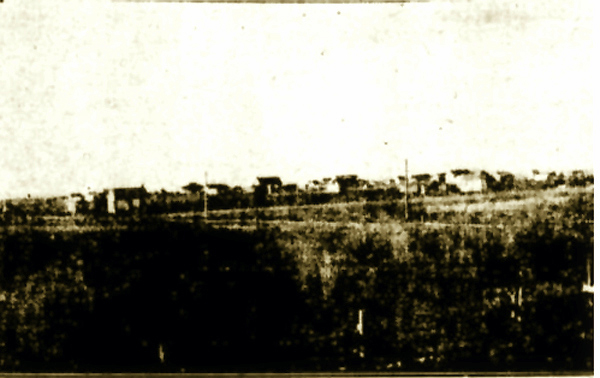
Lyman, 1911.
Lyman was founded about 1898 by Mormon colonists. The town was laid out on
the homestead of Samuel R. Brough (1857-1947), the same year as he was installed as a bishop of the
Latter Day Saints church. The area was originally called "Bench" but was renamed Owen
Abraham Owen Woodruff. Unfortunately there was already a post office in Wyoming
bearing the same name, It was thus named after Francis M. Lyman, an apostle
with the L.D.S. Church.
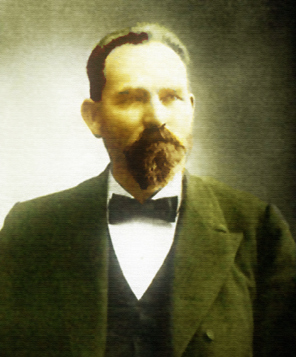 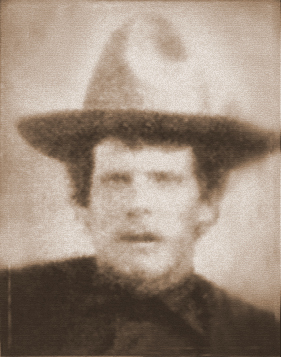
Left, Francis M. Lyman; right, Samuel R. Brough
Brough was the son of Mormon immigrants from England. At age 11 Brough was working on his own at
Hillard.
He was then called on Mission to the United Kingdon where he worked in South Wales, Ireland and
Scotland. In South Wales he was not particularly welcome and was attacked by an angry mob.
After complaining to the police, he was invited to leave town on a train. Upon his return to the
United States, he homesteaded at present-day Lyman,
proving up his homestead in 1897. In 1907,He acquired additional property by cash entry.
When he started developing his homestead, he worked as a tie hack. Lumber for the houses for
each of his two wives had to be hauled from the Uinta Mountains. Later he moved to
Bountiful, Utah. When he sold his property in Wyoming, he put in the deeds a restrictive covenant with possiility of reverter against
making or selling alcolic beverages on the property. This became of significance after Prohibition and licenses became available.
Two individuals applied for licenses and attempted to have Brough, then living in Salt Lake City,
release the covenants arguing that the consumption of beer would not cause drunkedness.
He refused.
About 1916 the Lincoln Highway was officially designated through the town. The American Automobile Association described the highway from Green River to Lyman as
"fairly well graveled to clay." By then the town had two hotels,
the Lyman operated by Mrs. Agnes Cunningham and the Marshal Hotel operated by Mrs. Ida Marshal.
In 1914, world traveller Effie Price Gladding crossed the continent. In 1915, she wrote of her adventures in Across the Contnent by the
Lincoln Highway. She recalled
Lyman:
A breeze sprang up toward sunset and we came in the twilight to the little
town of Lyman where the only hostel was The Marshal, half home and half
hotel, kept by Mrs. Marshall. As we came into the town the high, snowy
Wahsatch range was on our right. We had first seen its distant peaks about
twenty-four miles out of Evanston.
Mrs. Marshall gave us an abundant supper and we slept dreamlessly in a
little upper room with one window. Upon what a glory of sunrise did that
little upper window look out that morning of the first of July! The vast
landscape was bathed in lavender light, the Wahsatch range and the mountains
of our Eastern pathway catching the first glory of the coming sun,
while the plains were in deeper lavender.
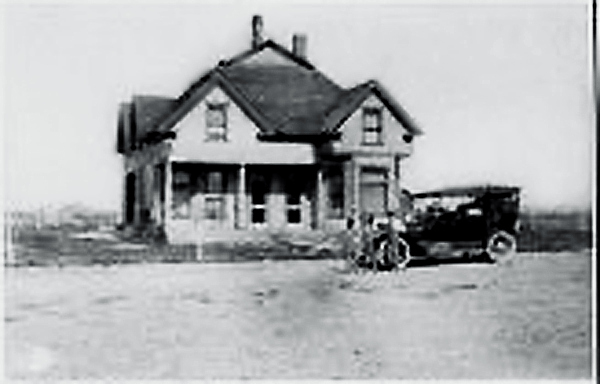
Marshal Hotel, Lyman, 1914.
The village street looked like a pathway of lavender. The little wooden,
painted houses, the barns, some red, some grey and unpainted, all glowed
with transforming light and color. Robins and meadow larks were singing.
Far, far to the northeast was a purple horizon line. The air was like wine.
I stayed at the window until I was half frozen in the cool morning air,
entranced by it all.
It was at Lyman that we heard talk of the ever smouldering feud between
cattlemen and sheepmen. Not far from Lyman is the “dead line” over which
sheepmen are not allowed to take their sheep. On the other side of this
stern boundary are the cattlemen, and they have issued a warning to the
sheepmen which they have more than once carried out. A few years ago a
sheepman either purposely or carelessly got over the dead line with his
sheep. He was mysteriously shot and two hundred of his sheep were killed
in one night. No one knows who the murderer was. Back in the shadows
looms the threat of the cattlemen, grim and real
We had been told in Wyoming of the buying of a big ranch by adjacent
ranch people in order that no sheepman might come in to share the water
and the ranges with the cattleman.
Cattle will not feed, they tell us, where sheep have fed, as the sheep
tear up the earth and also graze very closely. It is impossible for sheep
and cattle to graze comfortably on the same ranges.
In 1919, the ten-bed Marshal Hotel was purchased by Caroline C. Johnston (1874-1945) and became the Johnston Hotel.
Over the next ten years, Mrs. Johnston gradually expanded and remodelled the structure to a 41-bed facility.
"Mother" Johnsron, as she was known was also famous for her meals. The hotel also became the meeting place for the
local Lions Club.
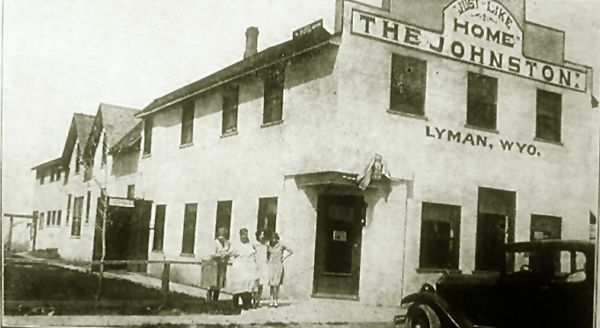
Johnston Hotel, Lyman, approx, 1928.
In the Evanston area Sheriff Louis D. Christenson (1880-1959) had raided six places that sold booze.
On the evening of October 10, 1921, the Sheriff, three or four deputies and two federal agents
were staying at the hotel. That night or they raided two stills near Mountain View
a short distance from Lyman. The town was amused by one of the deputies bring the remains of the still
back to Lyman strapped to a Ford with barbed wire. During the day, strangers were noticed riding about the town in a
Nash roadster. About four in the morning the Nash was spotted going past the
Johnston Hotel. The next morning, when the bank was opened , it was discovered that during the
night when the sheriff and his deputies were fast asleep, persons unknown but suspected of being the
stangers in the Nash, had broken into the bank and made a general mess of things in the Safe Deposit area.
No money was taken, the bank had purchased a new safe in which the money was kept. The Nash was never spotted again.
The hotel was equipped with its own power, refrigeration, water and heat. Beds had wool quilts and
hand crocheted bedspreads In October 1929, Mrs. Johnston sold the hotel to David E. Wand (1893-1966) from
Salt Lake City. Before moving to to California to take care of her elderly mother, Mrs. Johnson as a thank you to
the people of Lyman she hosted a dinner at the hotel for the Lions Club. The lions Club in turn made her the Lioness mother of the
Club and an honorary Lion. Next door to the hotel was a livery and boarding stable
and later a garage. Shortly thereafter Wand was married in Salt Lake City. Later that year the two
moved to Salt Lake City and later to Denver.
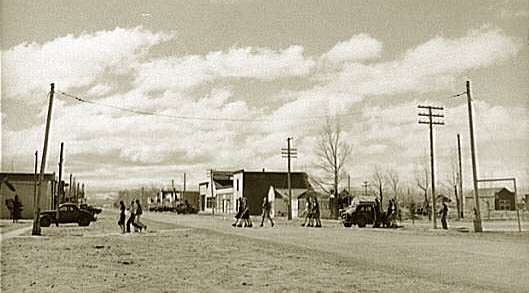
Lyman, approx. 1940
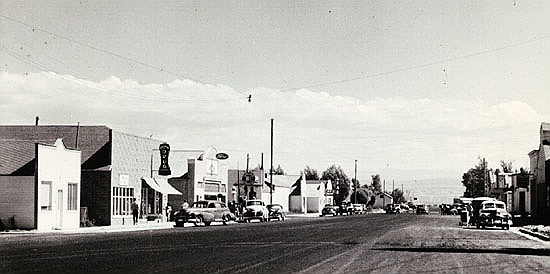
Lyman, approx. 1950.
Although in 1969 the town was by-passed by I-80, the town has become attractive as the
trees have been planted, new street lamps have been
installed, and American flags displayed.
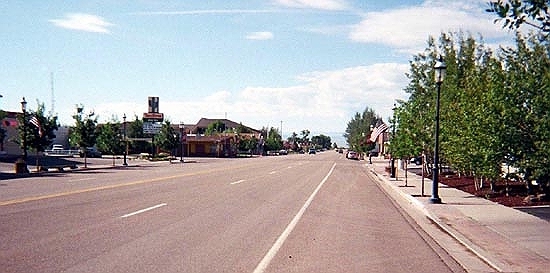
Lyman, 2003, Photo by Geoff Dobson
In memory of the day that Brigham Young first say the Salt Lake Vally the town every July celebrates
"Pioneer Days with a barbecue, rodeos, and historical re-enactments centering on the L.D.S. Church.
Next page: Lincoln Highway continued, Mountain View, the Town of Ft. Bridger and west.
|